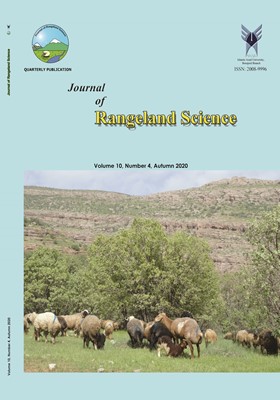Assessment of Feed Resources in Urban and Peri-urban Areas of Mid and High Land of Bale, Ethiopia
محورهای موضوعی : Sustainable Development
1 - Researcher at Sinana Agricultural Research Center
کلید واژه: feed resource, peri-urban, feeding constraints,
چکیده مقاله :
The survey was conducted in Urban and peri urban areas of mid and high land of Bale, Ethiopia during September 2016 to June 2017 with the objective of identifying available feed resources, its utilization methods and constraints related to feeding. The three major towns of Bale zone Ginir, Goba and Robe and the villages surrounding them that have a border with the town were included. A total of 180 households was selected using both purposive and random sampling techniques. Out of the total respondents, 66.1% indicated feed and feeding system as primary constraints. In peri-urban, the principal dry season feed resources available to livestock in the study area include crop-residue, stubble grazing, natural pasture and hay in their descending order. Milled grain, Agro-industrial byproduct and by product of local beverage “atela” are the main supplements used. In urban, feeds are mostly purchased from flour milling and oil producing houses. Despite high price and shortage of supplementary feeds, about 80% of the total respondents are supplementing concentrate to their dairy cattle. The total average protein and energy supplement provided per day for lactating cow is 0.94kg and 1.22kg, respectively which cost 0.93$ and 0.91$ in average in urban and peri urban area to produce the total average milk of 3.65 litters. The overall average daily dairy production output is 1.94$ birr and the average net profit is 0.07$ and 1.02$ per day/cow for local and hybrids, respectively. Feed quantity and quality problem was the first ranked, followed by lack of improved breed and health problem. Hence, to bring a meaningful increase in livestock productivity, livestock should be supplemented with a reasonable quantity and quality feeds. Similarly, the traditional husbandry practice, management of natural pasture and feeding value of crop residues should be improved.
Aliyi Kedu, 2015. Artificial Insemination Service Efficiency in Urban and Peri-Urban Dairy Production System in South East Oromia. An MSc thesis. Haramaya University, Ethiopia. Pp. 28-45.
Central Statistical Agency of Ethiopia (CSA). 2013. Population Projection of Ethiopia for All Regions at Wereda Level from 2014 – 2017. Central Statistical Agency, Addis Ababa, Ethiopia.
FAO. 2012. Balanced feeding for improving livestock productivity – Increase in milk production and nutrient use efficiency and decrease in methane emission, by M.R. Garg. FAO Animal Production and Health Paper No. 173. Rome, Italy.
Netherlands Development Organization (SNV). 2008. Study on Dairy Investment Opportunities in Ethiopia. Addis Ababa, Ethiopia
Solomon B., Melaku S., Yam1 A. 2009. The Interdependence Of Crop - Livestock Production Sectors: The Case Of Sinana Dinsho District In Bale Highlands Of Ethiopia. Journal Of Tropical And Sub-Tropical Agriculture. Vol. 42 (2)
Thrusfield M. 2005. Veterinary Epidemiology. 2nd ed. UK: Black Well Science. p 180.


